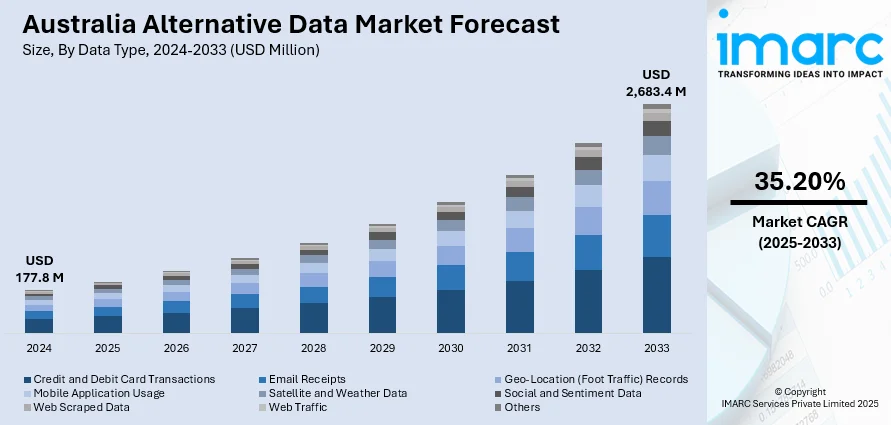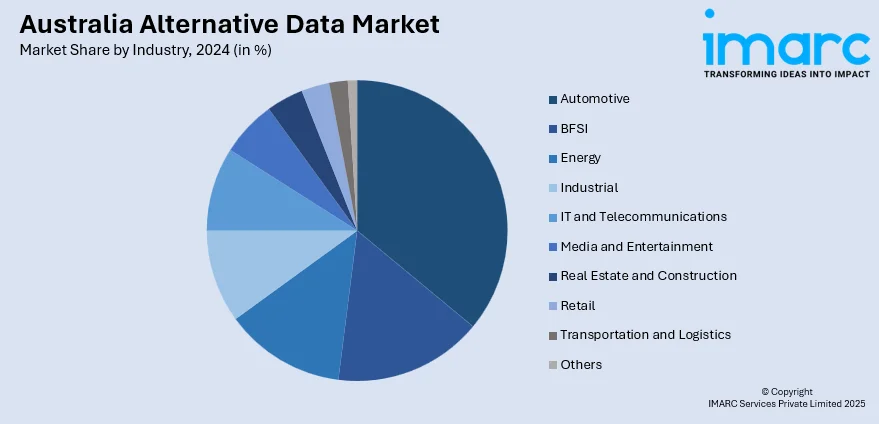
Australia Alternative Data Market Size, Share, Trends and Forecast by Data Type, Industry, End User, and Region, 2025-2033
Australia Alternative Data Market Size and Share:
The Australia alternative data market size reached USD 177.8 Million in 2024. Looking forward, IMARC Group expects the market to reach USD 2,683.4 Million by 2033, exhibiting a growth rate (CAGR) of 35.20% during 2025-2033. The rising demand for real-time insights, growing adoption of artificial intelligence (AI) and machine learning (ML), increased investment in fintech, regulatory support for data transparency, and expanding use of non-traditional data sources, including satellite imagery, web scraping, social media sentiment, and mobile app usage are some of the major factors augmenting the Australia alternative data market share.
|
Report Attribute
|
Key Statistics
|
|---|---|
|
Base Year
|
2024
|
|
Forecast Years
|
2025-2033
|
|
Historical Years
|
2019-2024
|
| Market Size in 2024 | USD 177.8 Million |
| Market Forecast in 2033 | USD 2,683.4 Million |
| Market Growth Rate 2025-2033 | 35.20% |
Australia Alternative Data Market Trends:
Rising Adoption of artificial intelligence (AI) and Machine Learning (ML)
The integration of artificial intelligence (AI) and machine learning (ML) into investment and financial analysis is a central trend influencing the Australia alternative data market growth. As financial institutions seek faster, more predictive tools to stay ahead of market shifts, AI and ML are becoming indispensable in identifying patterns and trends that traditional methods often miss. According to an industry report, Australian banks are at the forefront of this transformation, with 83% of banking executives confirming the implementation of AI within their organizations. This widespread adoption reflects a broader shift across the financial services sector, where the demand for real-time, data-driven decision-making is steadily increasing. Financial institutions and hedge funds are increasingly relying on advanced algorithms to extract actionable insights from vast datasets. AI and machine learning tools can process unstructured and unstructured data from diverse sources, such as satellite imagery, social media, news sentiment, or geolocation feeds in real-time. These capabilities allow investment firms to detect early signals of economic change, consumer behavior shifts, or supply chain disruptions well before traditional metrics reflect them. Moreover, Australia’s financial services sector, which includes major superannuation funds and asset managers, is investing in AI-driven platforms to differentiate their portfolios and enhance risk-adjusted returns, which is strengthening the market. The country’s regulatory openness toward innovation in fintech is also encouraging experimentation with these technologies. As a result, demand for tailored alternative datasets that can fuel proprietary AI models is increasing, thereby creating opportunities for specialized data vendors and technology partners in the Australian market.

To get more information on this market, Request Sample
Growing Demand from Non-Financial Sectors
There is an increased demand for the market from non-financial industries, which is positively impacting the Australia alternative data market outlook. Sectors such as retail, real estate, logistics, and healthcare are utilizing alternative datasets to optimize operations, improve customer engagement, and enhance forecasting accuracy. In line with this, real estate developers and urban planners are increasingly using foot traffic data, geospatial analytics, and building occupancy rates to assess the viability of new projects. Moreover, sentiment analytics are becoming key to retail strategy. According to industry reports, about 70% of purchase decisions are driven by emotion. Therefore, brands are using social media engagement, such as likes, comments, shares, and mentions, to understand consumer sentiment and loyalty. Also, retailers are leveraging web scraping and transactional data to fine-tune marketing strategies and track consumer preferences in near real-time. In the logistics and transportation sectors, alternative data such as fleet telematics, port activity, and weather patterns are analyzed to manage supply chain risks and increase delivery efficiency. This shift is also supported by Australia’s robust digital infrastructure and growing public-private data-sharing initiatives. As a result, demand for customized, sector-specific datasets is rising, encouraging the diversification of alternative data applications across the Australian economy.
Australia Alternative Data Market Segmentation:
IMARC Group provides an analysis of the key trends in each segment of the market, along with forecasts at the country level for 2025-2033. Our report has categorized the market based on data type, industry, and end user.
Data Type Insights:
- Credit and Debit Card Transactions
- Email Receipts
- Geo-Location (Foot Traffic) Records
- Mobile Application Usage
- Satellite and Weather Data
- Social and Sentiment Data
- Web Scraped Data
- Web Traffic
- Others
The report has provided a detailed breakup and analysis of the market based on the data type. This includes credit and debit card transactions, email receipts, geo-location (foot traffic) records, mobile application usage, satellite and weather data, social and sentiment data, web scraped data, web traffic, and others.
Industry Insights:

- Automotive
- BFSI
- Energy
- Industrial
- IT and Telecommunications
- Media and Entertainment
- Real Estate and Construction
- Retail
- Transportation and Logistics
- Others
A detailed breakup and analysis of the market based on the industry have also been provided in the report. This includes automotive, BFSI, energy, industrial, IT and telecommunications, media and entertainment, real estate and construction, retail, transportation and logistics, and others.
End User Insights:
- Hedge Fund Operators
- Investment Institutions
- Retail Companies
- Others
The report has provided a detailed breakup and analysis of the market based on the end user. This includes hedge fund operators, investment institutions, retail companies, and others.
Regional Insights:
- Australia Capital Territory & New South Wales
- Victoria & Tasmania
- Queensland
- Northern Territory & Southern Australia
- Western Australia
The report has also provided a comprehensive analysis of all the major regional markets, which include Australia Capital Territory & New South Wales, Victoria & Tasmania, Queensland, Northern Territory & Southern Australia, and Western Australia.
Competitive Landscape:
The market research report has also provided a comprehensive analysis of the competitive landscape. Competitive analysis such as market structure, key player positioning, top winning strategies, competitive dashboard, and company evaluation quadrant has been covered in the report. Also, detailed profiles of all major companies have been provided.
Australia Alternative Data Market Report Coverage:
| Report Features | Details |
|---|---|
| Base Year of the Analysis | 2024 |
| Historical Period | 2019-2024 |
| Forecast Period | 2025-2033 |
| Units | Million USD |
| Scope of the Report |
Exploration of Historical Trends and Market Outlook, Industry Catalysts and Challenges, Segment-Wise Historical and Future Market Assessment:
|
| Data Types Covered | Credit and Debit Card Transactions, Email Receipts, Geo-Location (Foot Traffic) Records, Mobile Application Usage, Satellite and Weather Data, Social and Sentiment Data, Web Scraped Data, Web Traffic, Others |
| Industries Covered | Automotive, BFSI, Energy, Industrial, IT and Telecommunications, Media and Entertainment, Real Estate and Construction, Retail, Transportation and Logistics, Others |
| End Users Covered | Hedge Fund Operators, Investment Institutions, Retail Companies, Others |
| Regions Covered | Australia Capital Territory & New South Wales, Victoria & Tasmania, Queensland, Northern Territory & Southern Australia, Western Australia |
| Customization Scope | 10% Free Customization |
| Post-Sale Analyst Support | 10-12 Weeks |
| Delivery Format | PDF and Excel through Email (We can also provide the editable version of the report in PPT/Word format on special request) |
Key Questions Answered in This Report:
- How has the Australia alternative data market performed so far and how will it perform in the coming years?
- What is the breakup of the Australia alternative data market on the basis of data type?
- What is the breakup of the Australia alternative data market on the basis of industry?
- What is the breakup of the Australia alternative data market on the basis of end user?
- What is the breakup of the Australia alternative data market on the basis of region?
- What are the various stages in the value chain of the Australia alternative data market?
- What are the key driving factors and challenges in the Australia alternative data market?
- What is the structure of the Australia alternative data market and who are the key players?
- What is the degree of competition in the Australia alternative data market?
Key Benefits for Stakeholders:
- IMARC’s industry report offers a comprehensive quantitative analysis of various market segments, historical and current market trends, market forecasts, and dynamics of the Australia alternative data market from 2019-2033.
- The research report provides the latest information on the market drivers, challenges, and opportunities in the Australia alternative data market.
- Porter's five forces analysis assist stakeholders in assessing the impact of new entrants, competitive rivalry, supplier power, buyer power, and the threat of substitution. It helps stakeholders to analyze the level of competition within the Australia alternative data industry and its attractiveness.
- Competitive landscape allows stakeholders to understand their competitive environment and provides an insight into the current positions of key players in the market.
Need more help?
- Speak to our experienced analysts for insights on the current market scenarios.
- Include additional segments and countries to customize the report as per your requirement.
- Gain an unparalleled competitive advantage in your domain by understanding how to utilize the report and positively impacting your operations and revenue.
- For further assistance, please connect with our analysts.
 Request Customization
Request Customization
 Speak to an Analyst
Speak to an Analyst
 Request Brochure
Request Brochure
 Inquire Before Buying
Inquire Before Buying




.webp)




.webp)












